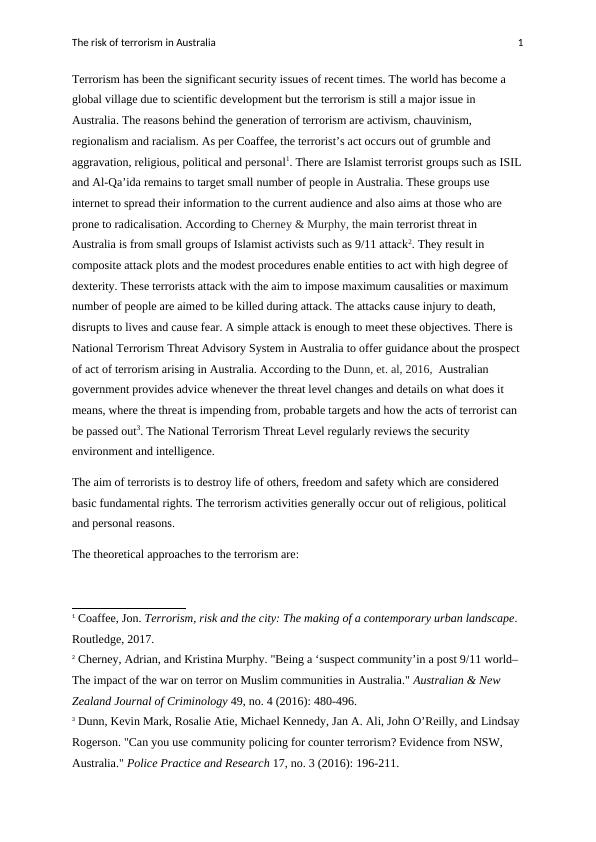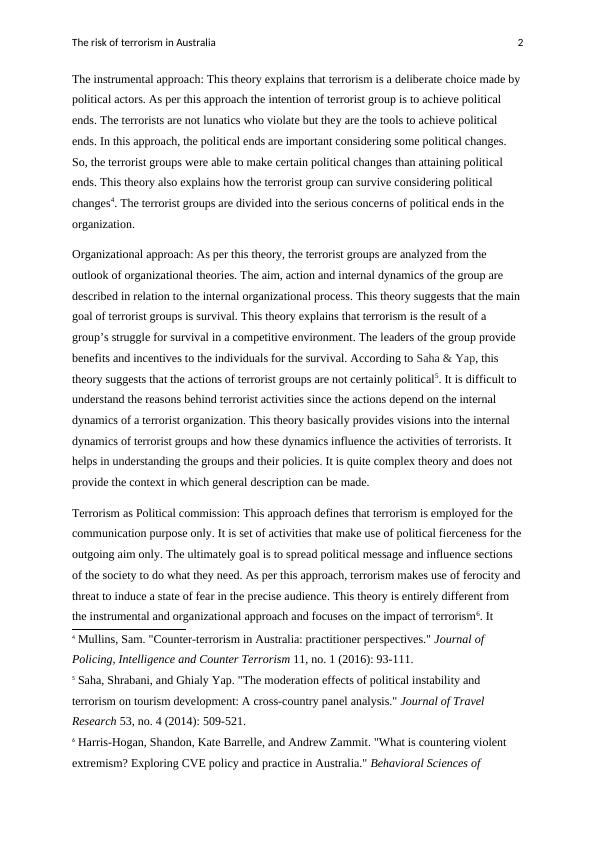The Risk of Terrorism in Australia
Added on 2023-06-10
7 Pages2623 Words73 Views
RUNNING HEAD: The risk of terrorism in Australia 0
The risk of terrorism in Australia
The risk of terrorism in Australia

The risk of terrorism in Australia 1
Terrorism has been the significant security issues of recent times. The world has become a
global village due to scientific development but the terrorism is still a major issue in
Australia. The reasons behind the generation of terrorism are activism, chauvinism,
regionalism and racialism. As per Coaffee, the terrorist’s act occurs out of grumble and
aggravation, religious, political and personal1. There are Islamist terrorist groups such as ISIL
and Al-Qa’ida remains to target small number of people in Australia. These groups use
internet to spread their information to the current audience and also aims at those who are
prone to radicalisation. According to Cherney & Murphy, the main terrorist threat in
Australia is from small groups of Islamist activists such as 9/11 attack2. They result in
composite attack plots and the modest procedures enable entities to act with high degree of
dexterity. These terrorists attack with the aim to impose maximum causalities or maximum
number of people are aimed to be killed during attack. The attacks cause injury to death,
disrupts to lives and cause fear. A simple attack is enough to meet these objectives. There is
National Terrorism Threat Advisory System in Australia to offer guidance about the prospect
of act of terrorism arising in Australia. According to the Dunn, et. al, 2016, Australian
government provides advice whenever the threat level changes and details on what does it
means, where the threat is impending from, probable targets and how the acts of terrorist can
be passed out3. The National Terrorism Threat Level regularly reviews the security
environment and intelligence.
The aim of terrorists is to destroy life of others, freedom and safety which are considered
basic fundamental rights. The terrorism activities generally occur out of religious, political
and personal reasons.
The theoretical approaches to the terrorism are:
1 Coaffee, Jon. Terrorism, risk and the city: The making of a contemporary urban landscape.
Routledge, 2017.
2 Cherney, Adrian, and Kristina Murphy. "Being a ‘suspect community’in a post 9/11 world–
The impact of the war on terror on Muslim communities in Australia." Australian & New
Zealand Journal of Criminology 49, no. 4 (2016): 480-496.
3 Dunn, Kevin Mark, Rosalie Atie, Michael Kennedy, Jan A. Ali, John O’Reilly, and Lindsay
Rogerson. "Can you use community policing for counter terrorism? Evidence from NSW,
Australia." Police Practice and Research 17, no. 3 (2016): 196-211.
Terrorism has been the significant security issues of recent times. The world has become a
global village due to scientific development but the terrorism is still a major issue in
Australia. The reasons behind the generation of terrorism are activism, chauvinism,
regionalism and racialism. As per Coaffee, the terrorist’s act occurs out of grumble and
aggravation, religious, political and personal1. There are Islamist terrorist groups such as ISIL
and Al-Qa’ida remains to target small number of people in Australia. These groups use
internet to spread their information to the current audience and also aims at those who are
prone to radicalisation. According to Cherney & Murphy, the main terrorist threat in
Australia is from small groups of Islamist activists such as 9/11 attack2. They result in
composite attack plots and the modest procedures enable entities to act with high degree of
dexterity. These terrorists attack with the aim to impose maximum causalities or maximum
number of people are aimed to be killed during attack. The attacks cause injury to death,
disrupts to lives and cause fear. A simple attack is enough to meet these objectives. There is
National Terrorism Threat Advisory System in Australia to offer guidance about the prospect
of act of terrorism arising in Australia. According to the Dunn, et. al, 2016, Australian
government provides advice whenever the threat level changes and details on what does it
means, where the threat is impending from, probable targets and how the acts of terrorist can
be passed out3. The National Terrorism Threat Level regularly reviews the security
environment and intelligence.
The aim of terrorists is to destroy life of others, freedom and safety which are considered
basic fundamental rights. The terrorism activities generally occur out of religious, political
and personal reasons.
The theoretical approaches to the terrorism are:
1 Coaffee, Jon. Terrorism, risk and the city: The making of a contemporary urban landscape.
Routledge, 2017.
2 Cherney, Adrian, and Kristina Murphy. "Being a ‘suspect community’in a post 9/11 world–
The impact of the war on terror on Muslim communities in Australia." Australian & New
Zealand Journal of Criminology 49, no. 4 (2016): 480-496.
3 Dunn, Kevin Mark, Rosalie Atie, Michael Kennedy, Jan A. Ali, John O’Reilly, and Lindsay
Rogerson. "Can you use community policing for counter terrorism? Evidence from NSW,
Australia." Police Practice and Research 17, no. 3 (2016): 196-211.

The risk of terrorism in Australia 2
The instrumental approach: This theory explains that terrorism is a deliberate choice made by
political actors. As per this approach the intention of terrorist group is to achieve political
ends. The terrorists are not lunatics who violate but they are the tools to achieve political
ends. In this approach, the political ends are important considering some political changes.
So, the terrorist groups were able to make certain political changes than attaining political
ends. This theory also explains how the terrorist group can survive considering political
changes4. The terrorist groups are divided into the serious concerns of political ends in the
organization.
Organizational approach: As per this theory, the terrorist groups are analyzed from the
outlook of organizational theories. The aim, action and internal dynamics of the group are
described in relation to the internal organizational process. This theory suggests that the main
goal of terrorist groups is survival. This theory explains that terrorism is the result of a
group’s struggle for survival in a competitive environment. The leaders of the group provide
benefits and incentives to the individuals for the survival. According to Saha & Yap, this
theory suggests that the actions of terrorist groups are not certainly political5. It is difficult to
understand the reasons behind terrorist activities since the actions depend on the internal
dynamics of a terrorist organization. This theory basically provides visions into the internal
dynamics of terrorist groups and how these dynamics influence the activities of terrorists. It
helps in understanding the groups and their policies. It is quite complex theory and does not
provide the context in which general description can be made.
Terrorism as Political commission: This approach defines that terrorism is employed for the
communication purpose only. It is set of activities that make use of political fierceness for the
outgoing aim only. The ultimately goal is to spread political message and influence sections
of the society to do what they need. As per this approach, terrorism makes use of ferocity and
threat to induce a state of fear in the precise audience. This theory is entirely different from
the instrumental and organizational approach and focuses on the impact of terrorism6. It
4 Mullins, Sam. "Counter-terrorism in Australia: practitioner perspectives." Journal of
Policing, Intelligence and Counter Terrorism 11, no. 1 (2016): 93-111.
5 Saha, Shrabani, and Ghialy Yap. "The moderation effects of political instability and
terrorism on tourism development: A cross-country panel analysis." Journal of Travel
Research 53, no. 4 (2014): 509-521.
6 Harris-Hogan, Shandon, Kate Barrelle, and Andrew Zammit. "What is countering violent
extremism? Exploring CVE policy and practice in Australia." Behavioral Sciences of
The instrumental approach: This theory explains that terrorism is a deliberate choice made by
political actors. As per this approach the intention of terrorist group is to achieve political
ends. The terrorists are not lunatics who violate but they are the tools to achieve political
ends. In this approach, the political ends are important considering some political changes.
So, the terrorist groups were able to make certain political changes than attaining political
ends. This theory also explains how the terrorist group can survive considering political
changes4. The terrorist groups are divided into the serious concerns of political ends in the
organization.
Organizational approach: As per this theory, the terrorist groups are analyzed from the
outlook of organizational theories. The aim, action and internal dynamics of the group are
described in relation to the internal organizational process. This theory suggests that the main
goal of terrorist groups is survival. This theory explains that terrorism is the result of a
group’s struggle for survival in a competitive environment. The leaders of the group provide
benefits and incentives to the individuals for the survival. According to Saha & Yap, this
theory suggests that the actions of terrorist groups are not certainly political5. It is difficult to
understand the reasons behind terrorist activities since the actions depend on the internal
dynamics of a terrorist organization. This theory basically provides visions into the internal
dynamics of terrorist groups and how these dynamics influence the activities of terrorists. It
helps in understanding the groups and their policies. It is quite complex theory and does not
provide the context in which general description can be made.
Terrorism as Political commission: This approach defines that terrorism is employed for the
communication purpose only. It is set of activities that make use of political fierceness for the
outgoing aim only. The ultimately goal is to spread political message and influence sections
of the society to do what they need. As per this approach, terrorism makes use of ferocity and
threat to induce a state of fear in the precise audience. This theory is entirely different from
the instrumental and organizational approach and focuses on the impact of terrorism6. It
4 Mullins, Sam. "Counter-terrorism in Australia: practitioner perspectives." Journal of
Policing, Intelligence and Counter Terrorism 11, no. 1 (2016): 93-111.
5 Saha, Shrabani, and Ghialy Yap. "The moderation effects of political instability and
terrorism on tourism development: A cross-country panel analysis." Journal of Travel
Research 53, no. 4 (2014): 509-521.
6 Harris-Hogan, Shandon, Kate Barrelle, and Andrew Zammit. "What is countering violent
extremism? Exploring CVE policy and practice in Australia." Behavioral Sciences of

End of preview
Want to access all the pages? Upload your documents or become a member.
Related Documents
Terrorism in the UK (DOC)lg...
|11
|2284
|181
THE CRIMINAL JUSTICElg...
|7
|1482
|18
Terrorism Awareness - Essaylg...
|12
|4040
|89
Terrorism and Local Law Enforcementlg...
|5
|1228
|62
102180 Countering Violent Extremism Policylg...
|9
|2707
|30
Paris Attack: Terrorism, Security Measures, and Law Enforcement Strategieslg...
|15
|3980
|359
